
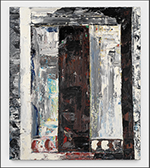
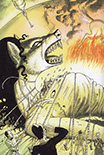
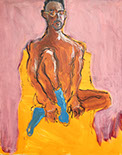

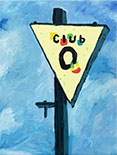

I.D.E.A.
Wiley, Kitsch, and Politics
by Michel Ségard
I.D.E.A. (Informed Discussion Engagement Area) is an infrequent feature that allows a person in the art world to express a personal opinion about an art world issue.
Sebastian Smee, The Washington Post art critic, recently penned a review of Kehinde Wiley’s show at the de Young Museum in San Francisco titled “Kehinde Wiley: An Archaeology of Silence.” Smee’s review is titled “Kehinde Wiley is selling kitsch.” But is he?
In his first paragraph, Smee states, “AI-generated art is sharpening our taste for art handmade by feeling and breathing artists,” an assertion that reminded me of the complaints about the photorealists in the late 1960s (Robert Bechtle, Charles Bell, Chuck Close, Robert Cottingham, Jeff Koons, Richard McLean, and most famously Richard Estes, among others). Then, after a time, it was feared that this photographic style would take the life out of the art of painting. Nothing of the kind happened, and a little more than 19 years later, the neoexpressionists (Anselm Kiefer, George Baselitz, Francesco Clemente, Philip Guston, Julian Schnabel, Jean-Michel Basquiat, and in Chicago, Wesley Kimler) emerged in the 1980s with their hyper gestural treatment.
Later, Smee complains that Wiley’s art is algorithmic and “leads with the concept, caring little for the sanctity and surprise of intuitive decision-making.” In the context of modern 20th-century art, concept also drove the art of Joseph Albers, Sol LeWitt, Carl Andre, Richard Serra, and Christo. An algorithmic approach may lead to deadening theoretical, academic exploration or minimalism devoid of human context, but it is, in itself, not kitsch.
GQ magazine described Wiley as “a self-styled Noah…called by calamity—[of] the world’s museums, flooded with whiteness—to bring the art world a salvational brownness.” That is actually not a bad description of Wiley’s intent. And putting Wiley’s works in Old Master galleries to unequivocally demonstrate that black and brown people are just as human and noble as white people is a sign that museums are finally edging into the 21st century. About time—this century is almost one quarter over.
Smee goes on to complain that you can buy skateboard decks with reproductions of Wiley’s images on them. In today’s world, you can get Monets or Van Goghs on a shopping bag, Hoppers in calendars, and any number of other images by famous artists on scarves, jackets, tee shirts, coffee mugs, etc. One must also remember that Keith Haring actually started a retail shop that sold items with his images on them as a means to distribute his work to common people of modest means. The distribution of art images on everyday items does not make the artist a producer of kitsch. It is the distribution system that makes these reproductions kitsch with illogical placement of images of artists’ works on improbable merchandise. And with this distinction, Smee is right to point the finger at museums, albeit indirectly. He complains about the art-speak and overblown accolades associated with the exhibition. However, that is not the work of Wiley; the responsibility for that atrocity of pretentious verbiage lies with the curatorial staff of the museum that mounted the show. It is a phenomenon that is not restricted to the de Young Museum; there is an epidemic of incomprehensible, pompous art speak throughout the art world.
About kitsch, Smee states: “Kitsch, in other words, is rooted in emotional cliché (the sweetness of children running on the grass, despair about living in a society riven by inequities). It is, at the same time, self-congratulatory (how nice!) and presumptuous. The presumption is that everyone feels the same way as you. Kitsch is a bully.” This passage brought to mind the Baroque masters who all played to the emotions of their audience, especially Bernini, Caravaggio, and Rubens. Are they kitsch? Some would think so. But the distinguishing quality of these artists that make them great is how emotional clichés are integrated into their work and used to carry out or provoke artistic discourse.
To argue for the creative force of accident in art, Smee quotes Francis Bacon who once said: “If anything ever does work in my case, it works from that moment when consciously I don’t know what I’m doing.” Smee argues: “Wiley’s art doesn’t work because he never doesn’t know what he’s doing.” That brings me to Bernini’s Ecstasy of Saint Teresa. Can you for a moment think that Bernini didn’t know what he was doing? Bacon’s remarks are in fact a romantic cliché promoting the myth of the solitary, tortured artist to which Smee has apparently subscribed.
Smee goes on to point out that Wiley’s work is largely manufactured by a troop of assistants. Wiley only does the figure once the intricate background has been completed—just like Rubens (and many other late Renaissance and Baroque masters). He complains that Wiley’s paintings have “no evidence of a thinking, feeling hand responding to light, shadow or color… We feel only the application of an assembly line formula.” How, then, does Smee feel about 17th-century Dutch still life paintings with all the trompe l'oeil execution? What Smee fails to consider is that the impersonal, manufactured floral backgrounds are equivalent to the Louis Vuitton initials used as a fabric pattern on purses and luggage, and as such, Wiley’s floral motifs function as a criticism of the high-end kitsch of White European culture.
Complaining about “the paintings’ garishly bright colors and immaculate surfaces displayed in dark, chapel-like galleries,” Smee equates them with “cheap Catholic kitsch,” by trying “to make something horrible and dehumanizing seem sacred and beautiful.” That sentiment suggests an anti-Catholic, even anti-Christian attitude. The historical fact is that Christianity has been doing just that for nearly 2,000 years, and that such practices had become the bedrock of most European art until the 19th century. Smee finishes his essay by saying: “By transmuting suffering into style, this show performs a similar operation. It exploits tragedy and the stench of societal failure only to deny its reality.” That act is exactly what Western, European art (the foundation of U.S. museum holdings) has been doing since the fall of Rome. Wiley has merely taken the black experience and presented it in white, European terms and not through the lens of exclusively black culture. Wiley is “signifying” white culture about their exclusion of Black culture in Western art history.
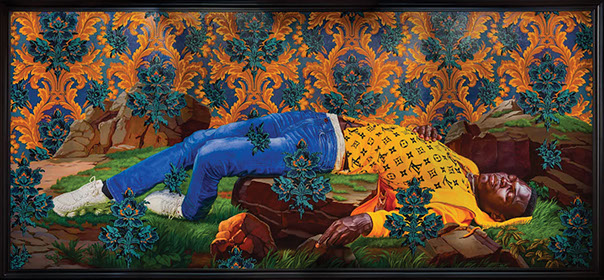
Kehinde Wiley, Femme piquée par un serpent (Mamadou Gueye), 2022. (Ugo Carmeni/Kehinde Wiley and Templon)
I am not arguing that Wiley is the greatest black painter of our time. But by using compositions from historic European art and the repetitive vegetative backgrounds that Smee calls kitsch (which is actually a symbolic copy of white bourgeois product decoration), Wiley presents the black experience in a new light and encourages white audiences to rethink their views about black art.
Michel Ségard is the Editor in Chief of the New Art Examiner and a former adjunct assistant professor at the School of the Art Institute of Chicago. He is also the author of numerous exhibition catalog essays.
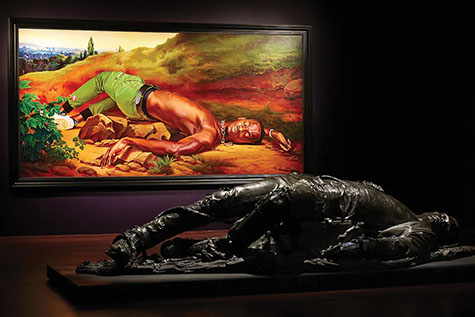
Installation view of “Kehinde Wiley: An Archaeology of Silence” at the de Young Museum in San Francisco. (Foreground) Young Tarentine (Mamadou Gueye), 2021, bronze, and (Background Tarentine 1 (Babacar Mane), 2022, oil on canvas. Photo: Samantha Tyler Cooper.
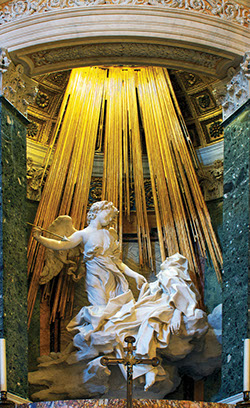
Gian Lorenzo Bernini, Ecstasy of Saint Teresa, 1647–1652. White marble and gilded stucco. Multi figure sculpture in Santa Maria della Vittoria, Rome. Photo: Wikipedia.